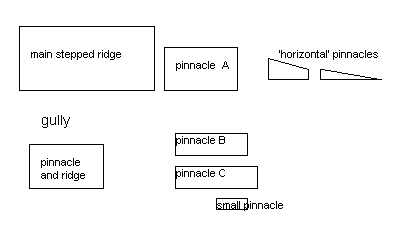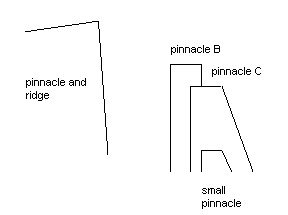Ceann Sibéal
Location: The attempts at climbing on Sybil Head in 1956 were confined to a series of clean, conglomerate pinnacles at the extreme south-west end. The geography of the region is sketched very roughly in the following diagrams. There are essentially two parallel lines of pinnacles, each running north to south into the sea.
Sybil Head - south-west end.
The ridges and pinnacles as seen directly from above:
The main ridge and pinnacles as seen from the west:
Approach: Descend a couple of steps of the Main Stepped Ridge, and then descend to the gully between that and the Pinnacle and Ridge. Descend the gully to the gap north of Pinnacle A. Cross Pinnacle A, Pinnacle B and Pinnacle C. Traverse around Pinnacle C and descend from a nick to the Small Pinnacle.
WEST FACE 55m V.Diff
B. McCall, F. Winder (leads shared) September 1956
This climb takes the easiest line up the west fact of Pinnacle C from the top of the Small Pinnacle. It is not hard, but it is exposed and slightly rotten.
1. 30m. Ascend the face on pebbly holds to the nick.
2. 25m. Traverse left from the nick, do a long pull-up and zigzag up.
The following information is taken from New Climbs 1986 & 1989.
Sybil Head - Dingle Peninsula. Sheet 70 OS Discovery Series GR Q 314 064
Hidden Slab. The slab is directly up from the Dún an óir Hotel, where the cliffs dip down to their lowest point, about 200m east of the look-out tower. A wall runs down from the top of the crag to the small village and the hotel. The rock is a hard, very clean sandstone at an angle of 70 degrees. The inclined surface is the bedding plane of an ancient beach, with the water ripple marks providing friction holds for climbing. The slab runs almost the entire height of the cliff, recessed amidst magnificent rock architecture.
Arabia Deserta 100m HVS 4b, 5a, 4c
This climb takes the most obvious line up the slab, a crack-line running straight up the L-hand (east) side, to mid-height, and then diagonally R-wards across the slab to finish on a grassy rake. The start of the climb is reached by scrambling down onto a grassy rake on the west side of the slab, and abseiling down for three rope lengths to large ledges at the bottom. The top abseil rope should probably be left in situ for a secure belay for the final pitch.
1/. 40m 4b Climb the crack for 40m to belay at a good ledge.
2/. 40m 5a Continue straight up the crack for 15m. Traverse R and continue up a thin crack, trending diagonall R-wards. Belay near a small incut ledge. (Abseil rope used for belay).
3/. 20m 4c Continue up the crack to the diagonal grassy rake on the R-hand side of the crag.
S. Gallwey, E. Hernstadt (alternate leads). May 1986
Note: with 50m ropes the route may be done in two pitches. The bottom belay should be taken in the recess above the main ledge, and the halfway belay should be taken a full rope length up the crack, just before it joins the L-hand corner of the slab, at a point where a thin crack branches off diagonally R, which is the second pitch.
The Empty Quarter 65m E1 54, 4b
This climb takes a meandering line up the central blank face of the upper half of the slab. This central section stands out somewhat from the rest of the slab, and is delineated at times by a vague overlap to either side. Protection is somewhat marginal in places, consisting mostly of No. 4, 5 & 6 rocks. placed on their backs in horizontal breaks (carry lots of each). The two pegs are more or less useless, though they serve somewhat to mark the line of the route. The grade given is for a pre-inspected ascent.
Start: Just above the halfway belay of "Arabia Deserta" (in the corner on the L of the slab) in a position where it is just possible to see the upper half of the slab.
1/. 40m Climb out R and then up towards a triangular recess in the face (good protection). Pass the recess on the R-hand side and climb diagonally R with very marginal protection to a peg. From above the peg traverse back L to another knife-blade peg, where somewhat better protection may be found. Climb straight up quartz for 3m and then move diagonally L-wards across fairly blank rock to the R-hand side of ledge to belay.
2/. 25m. Climb up the corner/arete and sometimes on the L wall , crossing a grass ledge, until broken ground is reached. Belay. Traverse off into the grass gully to the L of the face.
S. Gallwey, O. Jacob 5th June 1989.
Note: the L-hand corner, running the full length of the upper slab, has been climbed by a party that included D. Somers. Apart from it being at a 'reasonable grade' further details are not known.
SOUTHERN BUTTRESS
Access: On the south side of the head, two square buttresses are separated by an equally large square cut shallow recess. Abseil to a large ledge beneath the centre of the buttress that lies to the west. This abseil is a continuous 110m; take care with sharp edges near the top.
Magic Island, 100m, HVS 5a, 5a, 5a, Peter Britton, Colm Ennis 1/8/2010
Near the right hand end of the buttress, only one obvious crack system leads most of the way up the buttress. Start from some large boulders.
1. 33m, 5a. Enter the crack from the left and climb, via a recess, to where the crack crosses a left trending shallow ramp. Some awkward moves at the top of the ramp lead to the belay to the right near a horizontal quartz vein.
2. 29m, 5a. Climb the steep (size 3 cam) crack with excellent jamming moves until the crack terminates at a slab.
3. 38m 5a. (This recommended finish climbed by Stephen Galway, 21/8/2010.) Traverse delicately leftwards on a slab, with scant protection, firstly under a large square recess, then past a shallow left facing 3m corner and on to the left extremity of the slab from where the headwall above is breached to easier ground.
3.a 33m, 5a. (Original Britton-Ennis finish) Traverse leftwards as far as the shallow left facing 3m corner. Climb the corner with some committing moves and poor protection. Move then with more ease to the top. (A prussic on the abseil rope reduces the seriousness of the unprotected shallow corner and thus the grade to 4c).

